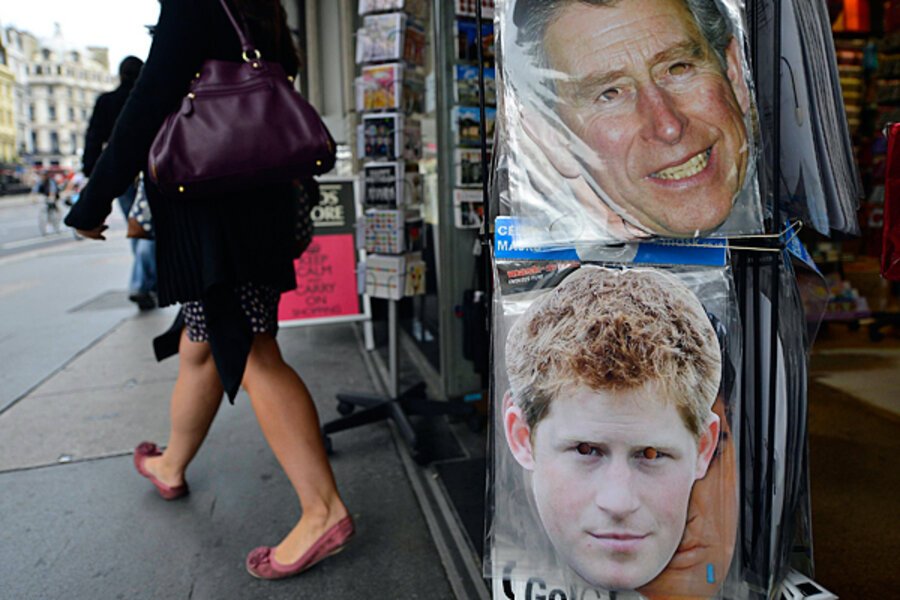As British press hold back on Harry pics, worries of a media chill
Loading...
| London
When pictures of Prince Harry, playing strip billiards in a Las Vegas hotel suite, appeared on websites and in newspapers around the world last week, it seemed like dream front page material for Britain's tabloid newspapers. After all, his family has long been fodder for Fleet Street: Prince William is believed to have had his phone hacked by journalists in 2005, and their late mother Princess Diana was famously plagued by tabloid paparazzi after she married Prince Charles.
But Britain’s scandal-loving press held back. Only one paper, The Sun, published the pictures, in what media critics hope – and journalists fear – may become an inhibited new norm for the British media.
The ostensible reason for their restraint was a letter written by Harbottle & Lewis, Prince Charles' lawyers, to the Press Complaints Commission (PCC), warning editors that the pictures should not be published as they were taken on "an entirely private occasion" where Harry had a "reasonable expectation of privacy."
But journalists have been quick to argue that newspapers would have published the pictures with alacrity had it not been for the ongoing Leveson inquiry into media standards, which is likely to recommend tougher regulation of the British press when it publishes its report this autumn.
Neil Wallis, former executive editor of the News of the World, told the BBC last week that the Leveson inquiry had “neutered” the press and that editors were “frightened of the consequences” of publishing such pictures.
A veteran Fleet Street reporter who has worked for Britain’s biggest tabloids agrees. “There’s a view that short-term limitation and caution are far, far better than not being able to do anything at all in the longer term,” says the journalist, who did not want to be named.
“What the public doesn’t know is the number of stories that have simply not been reported,” he adds. “At least every fortnight there’s been a scandal that we haven’t been able to write about. That classic tabloid terrain – they’ve just shut it down.”
Indeed, two days after The Sun broke ranks with Britain’s newspapers and published the photographs days after they first appeared on TMZ, a Los-Angeles-based celebrity gossip website, Rupert Murdoch, chief executive of The Sun's parent News Corporation, seemed to allude to this new climate of caution, arguing the paper had published the photographs to highlight the absence of “free press” in Britain.
“Need to demonstrate the no such thing as free press in the UK,” Murdoch tweeted on Sunday. “Internet makes mockery of these issues. 1st amendment please.”
The Leveson effect
In some ways it was a surprise that it was The Sun, Britain’s biggest-selling newspaper, that should have broken rank with Britain’s tabloid press over the Harry images. It was a phone hacking scandal at its sister publication, the now defunct News of the World newspaper, also owned by Murdoch’s News Corporation, which prompted the government to set up the Leveson inquiry.
A number of Sun journalists have been arrested as part of a parallel investigation into bribery, launched last year as the phone hacking scandal deepened.
Among the most shocking scandals that have been investigated over the past year is the alleged hacking by journalists of the mobile of a murdered schoolgirl, Milly Dowler, in 2002, which caused widespread fury.
Brian Cathcart, professor of journalism at Kingston University and a former deputy editor of the Independent on Sunday, believes that newspapers’ caution over the Harry pictures was prompted more by a growing sensitivity to public sentiment than explicit fears about the Leveson inquiry.
“Leveson is the manifestation of public horror and disgust at what had gone on before, especially with the Milly Dowler story,” he says. “Leveson was a response to that.”
The case of the Harry pictures, he added, would be unlikely to make much difference to Leveson’s final recommendations.
“It might be a reminder to Leveson, a case he might point to. But the man has spent a year digging around all this material – this is a long way from being the worst case of media intrusion.”
Breaking the rules
The Sun’s publication of the pictures was nonetheless a “flagrant and very illuminating example of ignoring the PCC,” says Mr. Cathcart. Few could disagree.
By heeding a warning made by Prince Charles’s lawyers via the PCC, tabloid newspapers were, after all, abiding by their own rules.
Clause 3 of the PCC’s Editors’ Code of Practice states that is “unacceptable to photograph individuals in private places without their consent.” Private places are defined as “public or private property where there is a reasonable expectation of privacy.”
The British public seems to agree that this is right. The PCC received more than 850 complaints on Friday about an alleged invasion of privacy in the case of the pictures. And more than two-thirds of Britons believed that The Sun was wrong to publish the pictures, according to a poll by Usury.
All of which suggests that the public would support tougher regulation of the British press.
As a recent blog post from the International Forum for Responsible Media and reposted on the website of Hacked Off, which campaigns for a more responsible media put it: “To keep the tabloids in line we need Lord Justice Leveson in permanent session. If this option is not available then statutory regulation seems the next best thing.”
The Fleet Street reporter, however, warned that tougher restrictions carried risks, too.
“So fine, the public isn’t finding out about sex scandals”, he says. “And who really cares about that? But there are also more significant scandals that are going unreported.… We can, for example, no longer talk to police and find out what they are doing. That is not a triumph.”







